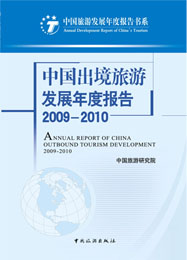Annual Report of China's Outbound Tourism Development 2009- 2010

Annual Report of China's Outbound Tourism Development 2009- 2010
Chapter One An Overview of China Outbound Tourism Development in 2009
Section One: Market Environment Analysis
1. Impact of the domestic environment
2. Impacts of International Environment
3. The Impacts of Related Market Environment
Section Two: Industry Operation and Product Innovation
1. The Industry Features of Outbound Tourism
2. The Operating State of the Majority Outbound Tourism Businesses
3. Outbound Tourism Product Development and Innovation
Section Three: Market Conditions and Tourist Behaviours
1. Market Conditions
2. Consumption Features
Chapter Two Analysis of China’s 2009 Outbound Tourism Market
Section One Impact of Domestic Environment
1. China’s economic aggregate and per capita income maintain a steady growth
2. Slight Decline of the RMB Exchange Rate
3. Financial crisis has not affected consumption confidence and willingness to spend money
4. Overall Downward Trend of China’s consumer price index (CPI)
5. Wage Adjustments’ Influence on Consumption
6. The further stringent control on official travel
7. Steady progress in Taiwan-oriented affairs and further promotion of cross-strait tourism
Section Two Impact of the International Environment
1. Enhancing Foreign Political and Economic Cooperation
2. More Convenient Visa Application Policy
3. Partial and Transient Characteristics of the impact of Influenza A H1N1
4. Thailand's political unrest and Indonesia’s bombings had limited influence
5. Destination countries /regions enhance their efforts of marketing in China
Section Three Impacts of Related Market Environment
1. Air routes were increasing while fuel price and bunker surcharges were also going up
2. Continued Improvement of Policies and Regulations
3. Improvement of Service Environment
Chapter Three The Operational Characteristics of China's Outbound Tourism Industry in 2009
Section one The Industry Features of Outbound Tourism
1. The entry barrier of the outbound tourism business was lower and the scale of the industry was expanding
2. The number of aviation port cities increased and unbalanced regional distribution is still obvious in the industry
3. More destinations were granted approved destination status and opportunities increased nationwide for most tourism enterprises to provide overseas services
4. The outbound tourism business grew rapidly and the foundation for the industry’s development was broadened
Section Two Trends in Outbound Tourism Operations
1. Tourism continued to be concentrated in certain regions, but a trend of decentralisation was seen for the first time
2. The conglomeration/collectivization of tourism-related organizations presented a “3+3” pattern and the process of “going out” was slow
3. The industry chain was extended and the vertical integration process was continuously moved forward
4. New types of businesses emerged and independent travel products became popular
5. The new edition of “Regulations on Travel Agencies” increased competition and made China’s tourism business more open
6. The effects of the financial crisis and Influenza A H1N1 were serious
Section Three: Outbound Tourism Product Development and Innovation
1. Outbound tourism products became increasingly diverse
2. Product brand-building was strengthened through cooperation
Chapter Four Market Structure and Consumption Traits of 2009 Outbound Tourism
Section One: Market Structure
1. Market situation
2. Market structure
3. Composition of major destinations
Section Two: Overall Analysis
1. Variables in outbound tourists’ consumption
2. Demographic characteristics of outbound tourists
3. Factors influencing consumers’ decisions
4. Characteristics of outbound tourists’ consumption decisions
5. Characteristics of outbound tourists’ consumption
6. Evaluation and future projections for outbound tourism
7. Correlation analysis of demographic characteristics of outbound tourists and tourism consumption
Section Three: Consumption Characteristics of Mainland Chinese Tourists in Major Destinations
1 Hong Kong SAR
2. Macau SAR
3. Taiwan China
4. Japan
5 The United States
6. Australia
7. South Africa
Section Four: Analysis of Outbound Tourists’ Satisfaction
1. Statistical analysis of visitors’ satisfaction
2. Integral satisfaction and quality perception index of tourism elements
Chapter Five Research on Major Tourist Source Markets
Section One: North China Market
1. Economy Overview
2. Development of Outbound Tourism
3. Development of Exit Ports
4. Case Study — Beijing
Section Two: East China Market
1. Economy Overview
2. Development of Outbound Tourism
3. Development of Exit Ports
4. Case Study — Shanghai
Section Three: The South China Market
1. Economy Overview
2. Development of Outbound Tourism
3. Development of Exit Ports
4. Case Study — Guangzhou
Section Four: Southwest Market
1. Economy Overview
2. Development of Outbound Tourism
3. Development of Exit Ports
4. Case Study — Chongqing
5. Case Study — Chengdu
Chapter Six Forecast and Recommendation for Outbound Tourism Developing Trend in China
Section One: The Outlook for Development Environment of Outbound Tourism in China
1. Judgment over Economical and Political Situation
2. Influential Factors from Policy and Social Environment
3. Influential Service Environment Factors
Section Two: Development Trend for Outbound Tourism in 2010
1. Outbound Tourism Scale Continues To Expand. Service Trade Deficit Further Increases
2. Enlargement of Outbound Tourism Destinations and Multi-Type Outbound Travel. Short Distance Travel and Sightseeing are the Main Modes of Foreign Travel. Visits to Taiwan, China, North America and Africa are likely to achieve new Breakthroughs
3. Competition over Development of Outbound Tourism Industry Is to Intensify; Visas to Destination Countries, Services with Chinese Environment Constrain the Development of Outbound Tourism
Section Three: Proposals to Promote Outbound Tourism Development in China
1. Recommendations for Governing Bodies
2. Recommendations to Tourism Enterprises
3. Proposals for Tourism Destination Countries /Regions
Editorial staff
